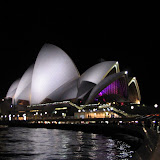
 Occasionally I find myself doing school work in Australia, though it doesn't really compare to Ithaca. This Thursday I have two presentations coming up, one of them about the Shipwreck Coast (Great Ocean Road area). The Coast gets its name from its coral reefs, jagged cliffs, rough seas, poor visibility, and its location on the Bass Straight. Ye olde tyme sailors referred to sailing through the Straight as "threading the needle" because there was so little room for error. The sinking of the Loch Ard is probably the most famous wreck on the coast, though it is one of only 800. Fifty-two people died when it sank, but they were British, so don't worry.
Occasionally I find myself doing school work in Australia, though it doesn't really compare to Ithaca. This Thursday I have two presentations coming up, one of them about the Shipwreck Coast (Great Ocean Road area). The Coast gets its name from its coral reefs, jagged cliffs, rough seas, poor visibility, and its location on the Bass Straight. Ye olde tyme sailors referred to sailing through the Straight as "threading the needle" because there was so little room for error. The sinking of the Loch Ard is probably the most famous wreck on the coast, though it is one of only 800. Fifty-two people died when it sank, but they were British, so don't worry.
While researching articles I found one that tried to make the sinking sound particularly gripping. I'd like to share it, with some of my own embellishments.
The
Loch Ard was almost 263 feet long, 38 feet wide, and weighed 1693 tons. It was a three-masted square rigged shipped that was built out of iron. It had been built in
Scotland in 1873, but usually sailed out of
England.
This fateful journey began on March 2, 1878, a day that will forever life in infamy, or something close to it. Young Captain Gibbs, a newly married man in the prime of his short 29 year life, knew nothing of the terror that awaited him three months later. Neither did the 53 other passengers and crew, who you can be assured were as pretty as Angelina Jolie, and as innocent as Michael Jackson’s boy toys.
 On the night of May 31 the travelers held a party to celebrate the anticipated end of their journey. Little Tom Pearce danced for the amusement of the lovely Miss Eva Carmichael. Even though he was just a sailor, and she was the daughter of a wealthy philanthropist, he spent his waking hours dreaming of her. Would she ever notice him?
On the night of May 31 the travelers held a party to celebrate the anticipated end of their journey. Little Tom Pearce danced for the amusement of the lovely Miss Eva Carmichael. Even though he was just a sailor, and she was the daughter of a wealthy philanthropist, he spent his waking hours dreaming of her. Would she ever notice him?

As Eva lay in bed that night, she thought of how much she loved her family, and how empty she would feel without them. She roused herself out of bed and checked on her parents and siblings, who were peacefully sleeping, safe and sound. FOR NOW….
Captain Gibbs spent a sleepless night awake at the wheel. He kept looking to see the Otway Lighthouse in the distance, but the fates seemed to be against him, and a thick fog rolled in, as if on cue. At 4am the fog lifted enough for one of the crew to cry out in an anguished voice that he could already see breakers, which is a very bad thing to see. The unwelcoming cliffs of Mutton Bird Island came into view, and little Captain Giblet realized that he had seriously effed things up. He tried to turn the ship around, but it lost momentum as it came about, and the bow turned back to the cliffs. The crew dropped their anchors to stabilize their boat and prevent it from going any further inland. The port bow anchor caught, water slopped over the poop deck, and lovely Eva was thrown up into the aft starboard mizzen rigging. The bow swung around, the boat was pointing away from the cliffs, and Captain Gibbs unfurled the sails to tack out to sea. Passengers and crew rejoiced. They would all survive this horrible ordeal!
JUST THEN the hull of the boat struck a reef half a mile off of Mutton Bird Island. “Waves broke over the ship and the top deck was loosened from the hull. The masts and rigging came crashing down knocking passengers and crew overboard. It took time to free the lifeboats and when one was finally launched, it crashed into the side of the Loch Ard and capsized. Tom Pearce, who had launched the boat, managed to cling to its overturned hull and shelter beneath it. He drifted out to sea and then on the flood tide came into what is now known as Loch Ard Gorge. He swam to shore, bruised and dazed, and found a cave in which to shelter.
“Some of the crew stayed below deck to shelter from the falling rigging but drowned when the ship slipped off the reef into deeper water.
“Eva Carmichael had raced onto deck to find out what was happening only to be confronted by towering cliffs looming above the stricken ship. In all the chaos, Captain Gibbs grabbed Eva and said, ‘if you are saved Eva, let my dear wife know that I died like a sailor.’ That was the last Eva Carmichael saw of the Captain. She was swept off the ship by a huge wave.
“Clinging to a spar, the young woman spent five hours in the water until she too was swept into Loch Ard Gorge. She saw Tom Pearce on a small rocky beach and yelled to attract his attention. He dived in and swam to the exhausted woman and dragged her to shore. He took her to the cave and broke open a case of brandy which had washed up on the beach. He opened a bottle to revive the unconscious woman.
“A few hours later Tom scaled a cliff in search of help. He followed hoof prints and came by chance, upon two men from nearby Glenample Station three and a half miles away. In a state of exhaustion, he told the men of the tragedy. Tom returned to the Gorge while the two men rode back to the station to get help.”
And that, my friends, is the mostly true story of the Loch Ard’s last voyage. The wreckage can still be seen to this day and is accessible to scuba divers. Other artifacts, including a Minton porcelain peacock and floor tiles, are on display at the Flagstaff Hill Maritime Museum in Warrnambool. Whatever happened to Tom and Eva, the sole survivors? Well, I’ll tell you. Tom was given a hero’s welcome in Melbourne: one thousand pounds from the Victorian government, a gold medal from the Royal Humane Society of Victoria, and numerous concerts to honor him and others who lost family members in the Loch Ard disaster. Eva spent six weeks convalescing at the Glenample Station. When her health had returned, she bid Tom adieu and left for Ireland, this time on a steamship.

On the night of May 31 the travelers held a party to celebrate the anticipated end of their journey. Little Tom Pearce danced for the amusement of the lovely Miss Eva Carmichael. Even though he was just a sailor, and she was the daughter of a wealthy philanthropist, he spent his waking hours dreaming of her. Would she ever notice him?













No comments:
Post a Comment